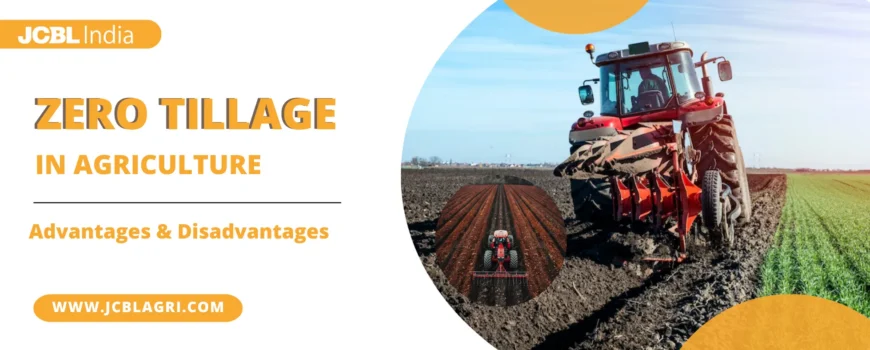In modern agriculture, the quest for sustainable farming practices has become increasingly urgent. Zero tillage is one of the methods that is gaining popularity, it is a technique that challenges traditional farming norms by eliminating or significantly reducing mechanical soil disturbance. This blog delves into the advantages and disadvantages of zero tillage, shedding light on its potential to revolutionize agriculture while acknowledging its hurdles.
What is Zero Tillage?
Zero tillage known as no-till farming, involves planting crops into untilled soil, leaving the previous crop residues on the surface. Unlike conventional tillage, which involves plowing and cultivating the soil to prepare it for planting, zero tillage minimizes soil disturbance to preserve its structure and health.
Advantages of Zero Tillage
1. Environmental Benefits
Zero tillage promotes soil conservation by reducing erosion and maintaining soil structure. By keeping crop residues on the surface, it shields the soil from wind and water erosion, preserving valuable topsoil and preventing sedimentation in water bodies. Additionally, the minimal soil disturbance promotes carbon sequestration, contributing to climate change mitigation efforts.
2. Economic Advantages
Because zero tillage farmers rely less on machinery and tillage operations, they pay less for fuel and labor. Moreover, the enhanced soil structure and organic matter content result in improved water retention and nutrient availability, reducing the need for irrigation and fertilizers. Over time, this can increase farm profitability and resilience to climate variability.
3. Agricultural Sustainability
Zero tillage promotes biodiversity by offering shelter and safety to beneficial species in the soil. As soil health improves, so does the overall resilience of agroecosystems, reducing the dependence on external inputs and mitigating the risk of crop failures. By embracing zero tillage, farmers contribute to the long-term sustainability of agricultural landscapes and ecosystems.
Disadvantages of Zero Tillage
1. Initial Implementation Challenges
Switching to zero tillage requires adjustments in equipment and management practices, which can be costly and time-consuming. Farmers may also face challenges in weed and pest management, especially during the early stages of adoption. Additionally, it may take time for the soil to adapt to reduced tillage, potentially affecting crop establishment and yields.
2. Potential Yield Reductions
While zero tillage offers long-term benefits for soil health, farmers may experience temporary reductions in crop yields during the transition period. Effective weed control and nutrient management strategies are essential to minimize yield losses and ensure the success of zero tillage systems. Moreover, the outcomes may vary depending on crop types, soil conditions, and regional factors.
3. Socio-Economic Considerations
The adoption of zero tillage may pose challenges for small-scale farmers with limited access to resources and technical support. Economic factors, such as market prices and government policies, can influence the profitability and viability of zero tillage systems. To promote widespread adoption, policymakers need to provide incentives and support mechanisms tailored to the needs of diverse farming communities.
Two Basic Methods of No-Till Farming
No-till farming, also known as zero tillage or conservation tillage, employs practices that minimize soil disturbance, preserving its structure and health. Here are two basic methods of implementing no-till farming:
Direct Seeding:
Direct seeding involves planting seeds directly into untilled soil, without prior plowing or cultivation. In this method, crop residues from the previous harvest are left on the soil surface to serve as mulch. The mulch helps to suppress weed growth, retain soil moisture, and regulate soil temperature. Farmers may use specialized equipment, such as no-till drills or seeders, to sow seeds into the untilled soil. Direct seeding is commonly used in large-scale farming operations, where efficiency and cost-effectiveness are crucial.
Cover Cropping:
Cover cropping involves planting a cover crop, such as legumes or grasses, to protect the soil during fallow periods or between cash crop rotations. The cover crop serves multiple purposes, including erosion control, nutrient cycling, and weed suppression. When the cover crop reaches maturity, it can be terminated through mowing, rolling, or herbicide application, leaving behind a layer of organic residue on the soil surface. This residue acts as a mulch, providing a protective cover for the soil and promoting soil health.
Conclusion
As we navigate the complexities of modern agriculture, zero tillage emerges as a promising pathway toward sustainability and resilience. By weighing its advantages and disadvantages, farmers can make informed decisions that balance environmental stewardship with economic viability. Through research, innovation, and collaboration, we can unlock the full potential of zero tillage to shape a more sustainable future for agriculture and the planet.

